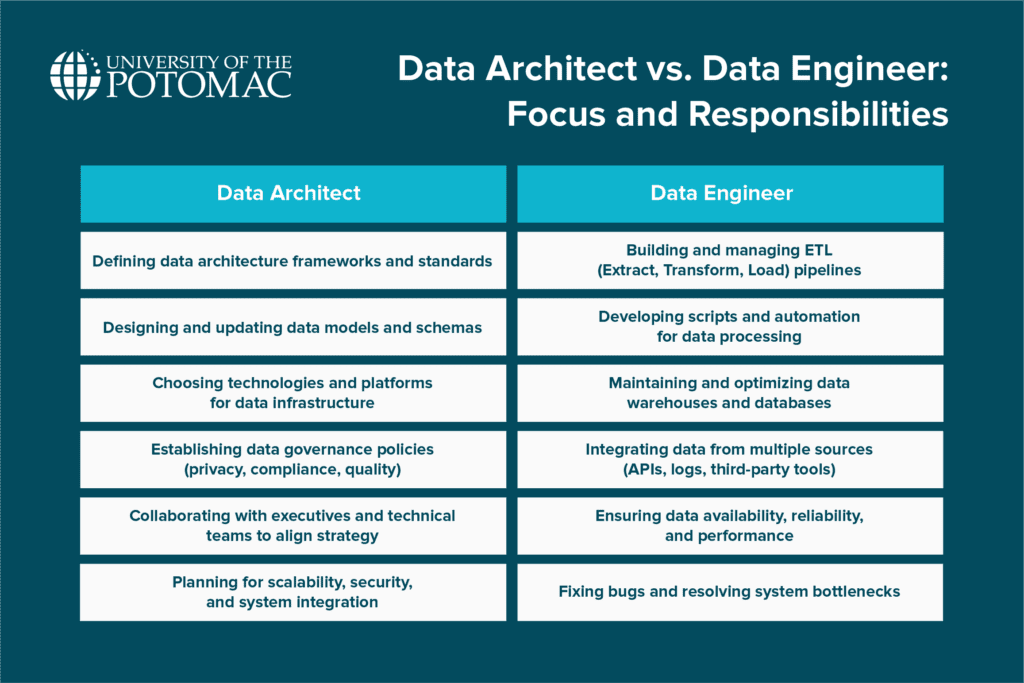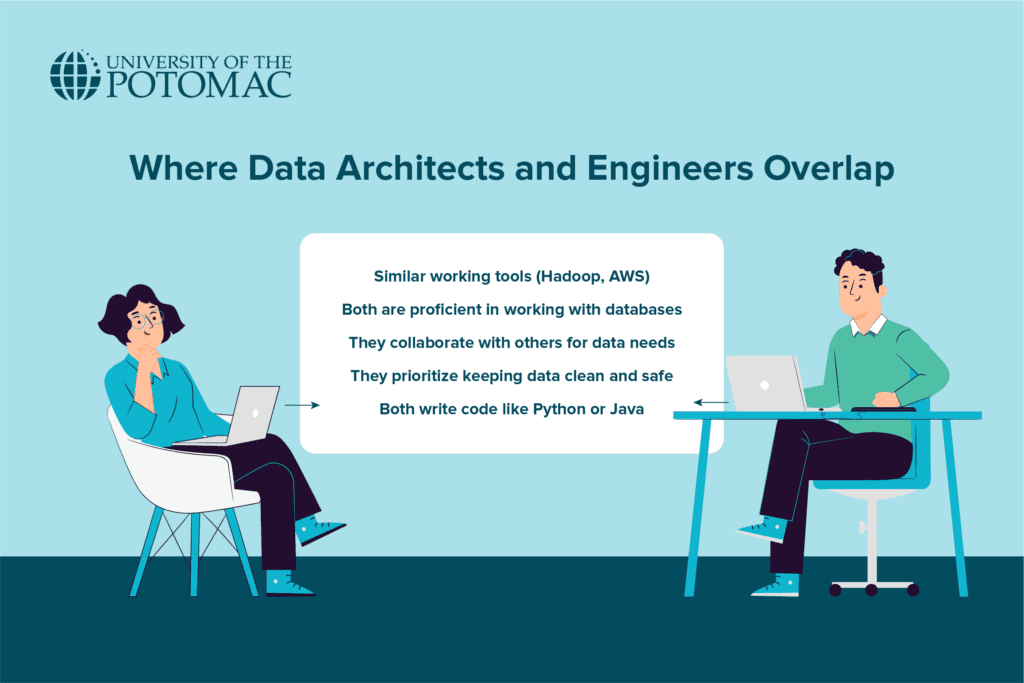Key Takeaways
- Data architects plan, and data engineers build—architects focus on structure and strategy, while engineers handle hands-on development and data flow.
- Both roles are in high demand. Industries like finance, healthcare, and tech are hiring aggressively for both positions.
- Career paths are flexible; with the right skills and training, professionals can move between roles and grow into senior-level positions.
Imagine trying to build a skyscraper without an architect or a construction crew. That is what managing data looks like without the right professionals. As businesses collect more information than ever before, the need for clear data strategies has skyrocketed. This surge has pushed data-related roles into the spotlight as some of the fastest-growing occupations.
However, one thing remains blurry for many: what exactly is the difference between a data architect and a data engineer? These two roles are in high demand but often misunderstood. Let’s clear that up.
What Is a Data Architect?
A data architect is the mastermind behind how an organization’s data is structured. Think of them as the blueprint designers who lay out the framework for storing, integrating, and managing data across systems.
They work closely with business leaders and IT teams to understand goals and turn them into a long-term data strategy. Most data architects operate in cloud environments or hybrid systems, ensuring data flows securely, efficiently, and in a way that supports future growth.
You’ll find data architects in tech, healthcare, finance, retail, and government. Anywhere data is crucial for decision-making, a data architect is usually behind the scenes, making sure everything works smoothly and safely.
What Is a Data Engineer?
A data engineer is the builder who brings the architect’s vision to life. While the data architect sets the strategy, the data engineer gets hands-on with the tools, coding, and systems that process and move data. They typically work in cloud-based or big data environments, handling massive volumes of information across different platforms.
Data engineers work across industries like e-commerce, banking, logistics, healthcare, and entertainment. Any business that collects user behavior, financial transactions, or sensor data needs skilled engineers to make sense of it all. Without them, even the best-designed data strategies would sit idle, waiting to be activated.
Data Architect vs. Data Engineer: Key Differences
While both roles work within the data ecosystem, their roles differ significantly. The educational and training requirements needed, as well as their annual salaries, also vary.
Focus and responsibilities
The primary distinction between a data architect and a data engineer lies in their focus. A data architect operates at the strategic level, planning how data should be organized and accessed across the entire business. In contrast, a data engineer works on the operational side, building and maintaining the systems that move and store the data in real time.

The main focus of a data architect lies in:
- Defining data architecture frameworks and standards
- Designing and updating data models and schemas
- Choosing technologies and platforms for data infrastructure
- Establishing data governance policies (privacy, compliance, quality)
- Collaborating with executives and technical teams to align strategy
- Planning for scalability, security, and system integration
Data engineers, on the other hand, are tasked with:
- Building and managing ETL (Extract, Transform, Load) pipelines
- Developing scripts and automation for data processing
- Maintaining and optimizing data warehouses and databases
- Integrating data from multiple sources (APIs, logs, third-party tools)
- Ensuring data availability, reliability, and performance
- Fixing bugs and resolving system bottlenecks
Skill sets and tools
Both data architects and data engineers work with similar technologies, but how they use them and why can be very different. Their skill sets overlap, yet each role leans into a specific side of the data process.
For data architects, these skills are necessary:
- Strong understanding of databases and how information is organized
- Knowledge of SQL and data modeling tools
- Familiarity with cloud platforms like AWS, Azure, and Google Cloud
- Working with big data tools like Hadoop and Spark, but more from a planning view
- Strong communication and strategic thinking to design systems that match business goals
Successful data engineers are:
- Experienced in writing code using Python, SQL, and sometimes Java or Scala
- Proficient in data pipelines using ETL tools like Apache NiFi, Airflow, or Talend
- Familiar with cloud platforms and big data systems like Spark or Kafka
- Focused on problem-solving, debugging, and improving system performance
- Comfortable managing large amounts of data from different sources
Education and training
Both data architects and data engineers usually begin with a degree in computer science, information technology, or data science. A bachelor’s degree is the most common starting point, while a master’s can help professionals move into more advanced roles.
University of the Potomac is the place to be for either of these pursuits. We offer degrees like the Bachelor and Master of Science in Computer Science and the Master of Science in Information Technology, along with internship opportunities that give students real-world experience to prepare for data careers.
When it comes to training, data architects often focus on system design, data modeling, and long-term planning. They benefit from training that includes strategic thinking, database theory, and data governance.
Data engineers, by contrast, need strong coding skills and hands-on experience building data pipelines, managing databases, and using tools that process large amounts of information.
Certifications are a great way to stand out. Data engineers often pursue AWS, Google Cloud, or Microsoft Azure certifications, while data architects might go for advanced training in data modeling or enterprise architecture.
Career path and progression

Both data architects and data engineers have clear career ladders, starting with entry-level roles and progressing to senior leadership positions.
Data architects typically start with:
- Entry-level: Data Modeler, Junior Data Architect
- Mid-level: Data Architect, Solutions Architect
- Senior-level: Senior Data Architect, Chief Data Officer
A data engineer’s path looks like:
- Entry-level: Junior Data Engineer, Data Analyst
- Mid-level: Data Engineer, ETL Developer
- Senior-level: Senior Data Engineer, Data Engineering Manager
Switching from engineer to architect is common, as hands-on experience helps architects understand practical challenges. Both paths offer growth and chances to shape how companies use data.
Interested in pursuing a degree?
Fill out the form and get all admission information you need regarding your chosen program.
This will only take a moment.
Message Received!
Thank you for reaching out to us. We will review your message and get right back to you within 24 hours.
If there is an urgent matter and you need to speak to someone immediately you can call at the following phone number:
- We value your privacy.
Salary and job outlook
In 2025, the average salary for a data architect in the U.S. is approximately $133,000, with total compensation reaching around $171,000, including bonuses and equity. For data engineers, the average base salary is lower, averaging about $105,000, with total compensation reaching $129,000.
Several factors influence salary levels, including experience, location, industry, and education and certifications. The more qualified you are, the better the chances of a higher salary.
The demand for both roles is robust. Employment of database administrators and architects, which includes data architects, is projected to grow 9% from 2023 to 2033, faster than the average for all occupations. Similarly, data engineers are in high demand across various industries, with more than 20,000 new jobs opened last year.
Similarities Between Data Architects and Data Engineers

Even though their jobs are different, data architects and data engineers share many skills and work closely together.
- Both use tools like Hadoop, Spark, and cloud services like AWS.
- They are proficient in working with databases using SQL.
- Both talk to analysts, scientists, and business teams to understand data needs.
- They focus on keeping data clean and safe.
- Both write code, often in Python or Java, to handle data tasks.
- Paying attention to details and fixing problems quickly is important for both.
Data architects plan how data should flow, and data engineers build and keep those systems running. They depend on each other to make sure the data is useful and easy to access. Working as a team, they help businesses make smart decisions with data.
Choosing the Right Role for You
Deciding between a career as a data architect or a data engineer starts with understanding what excites you most about working with data.
If you enjoy big-picture thinking, designing systems, and planning how data should flow through an organization, a data architect role might suit you better. On the other hand, if you love hands-on work, coding, building data pipelines, and solving technical problems daily, then data engineering is likely a better fit.
Your preferred work style matters too. Data architects often collaborate with business leaders and focus on long-term solutions, while data engineers spend more time writing code and managing infrastructure.
Education also plays a role—both paths usually require degrees in computer science, IT, or related fields, but architects often benefit from advanced studies in system design and strategy. Engineers focus more on programming and practical tool skills.
If you start in one role but want to switch, reskilling is completely doable. The skills overlap, and many professionals move between these paths by learning new tools or gaining experience in the other area. Staying curious and open to growth will keep your career flexible and rewarding.
Conclusion
Data architects and data engineers both work with data, but in very different ways. Architects focus on designing the overall structure and strategy, while engineers handle the building, coding, and daily operations. Choosing between the two depends on your strengths, interests, and work style.
Whether you enjoy planning or prefer hands-on problem-solving, there is a clear path for growth in either role. If you’re ready to start or switch your career in tech, University of Potomac offers flexible degree programs in computer science and information technology designed to help you succeed. Take the first step toward your future today.
Frequently Asked Questions
Is a data architect a higher role than a data engineer?
Yes, a data architect typically holds a more senior, strategic position focused on planning and design, while data engineers are responsible for building and maintaining the systems.
Can a data engineer become a data architect?
Absolutely — with experience, system design knowledge, and strong communication skills, many data engineers transition into data architect roles.
What is the work-life balance like for a data architect compared to a data analyst?
Data architects often face more pressure during system planning or migration phases but generally enjoy a balanced schedule. Data analysts usually have steadier day-to-day tasks, making their work-life balance slightly more predictable.










